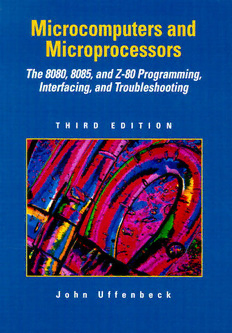Table Of ContentSECOND EDITION
AND_
MICROPROCESSORS
THE 8080,8085, AND Z-80
PROGRAMMING, INTERFACING,
AND TROUBLESHOOTING
JOHN UFFENBECK
OOLf . lb U l'‘:
COVENTRY
UNIVERSITY
LANCHESTER LIBRARY
800
LANCHESTER LIB RAF v\ Coventry U
Much Park Street 7HF
)
MICROCOMPUTERS
AND
MICROPROCESSORS
The 8080, 8085, and Z-80
Programming, Interfacing,
and Troubleshooting
Second Edition
John Uffenbeck
Prentice Hall, Inc.
Englewood Cliffs, New Jersey 07632
Library of Congress Cataloging in Publication Data
Uffenbeck, John E.
Microcomputers and microprocessors : the 8080, 8085, and Z-80 :
programming, interfacing, and troubleshooting / John Uffenbeck. —
2nd ed.
p. cm.
Includes index.
ISBN 0-13-584061-9
1. Microcomputers. 2. Intel 8080 (Microprocessor) 3. Intel 8085
(Microprocessor) 4. Zilog Z-80 (Microprocessor) I. Title.
QA76.5.U35 1991
004. 16—dc20 90-36041
CIP
Editorial/production supervision: Tally Morgan, Wordcrafters Editorial
Services, Inc.
Cover design: Butler/Udell Design
Manufacturing buyer: Ed O’Dougherty
© 1991, 1985, by Prentice-Hall, Inc.
A Division of Simon & Schuster
Englewood Cliffs, New Jersey 07632
All rights reserved. No part of this book may be
reproduced, in any form or by any means,
without permission in writing from the publisher.
Printed in the United States of America
10 9 8 7 6 5
ISBN D-lB-SflMQbl-T
Prentice-Hall International (UK) Limited, London
Prentice-Hall of Australia Pty. Limited, Sydney
Prentice-Hall Canada Inc., Toronto
Prentice-Hall Hispanoamericana, S.A., Mexico
Prentice-Hall of India Private Limited, New Delhi
Prentice-Hall of Japan, Inc., Tokyo
Simon & Schuster Asia Pte. Ltd., Singapore
Editora Prentice-Hall do Brasil, Ltda., Rio de Janeiro
University
Hnvpntrv
Contents
PREFACE
1 INTRODUCTION TO THE MICROPROCESSOR
1.1 Digital Computers: Some Basics 2
The stored program computer 2
Fetch and execute 4
The three-bus architecture 4
Computer programming 5
1.2 Computer Codes 5
Bits and bytes 6
Binary, decimal, and hexadecimal numbers 7
Codes 10
1.3 Computer Languages 12
Machine and assembly language programming 12
High-level languages 14
1.4 Implementing the Three-Bus Architecture in Hardware 16
Digital signals 16
Defining the three buses 19
1.5 The CPU as a Complex Timer 21
Machine cycle timing diagrams 21
Instruction timing 23
Processor timing 23
Chapter Summary 26
Lab Projects 27
Questions and Problems 28
Key Concept Answers 31
2 INTRODUCING THE 8080, 8085, AND Z-80
MICROPROCESSORS
2.1 Constructing the CPU Module 32
The CPU module 33
2.2 CPU Modules for the 8080, 8085, and Z-80
Microprocessors 36
The 8080 CPU module 36
The 8085 CPU module 42
The Z-80 CPU module 46
2.3 Programming Models for the 8080, 8085, and Z-80
Microprocessors 51
A programming model for the 8080 51
The 8080 flag register 52
A programming model for the 8085 55
A programming model for the Z-80 55
The Z-80 flag register 55
2.4 Introducing the Instruction Sets 57
Instruction types 57
2.5 Addressing Modes 66
68
2.6 Putting It All Together: A Programming Example
Chapter Summary 70
Lab Projects 71
Questions and Problems 72
Key Concept Answers 76
3 PROGRAMMING THE MICROPROCESSOR
3.1 Microprocessor Programming Examples 79
Program 1: 8080185 8-bit addition 79
Program 2: Z-80 8-bit addition 81
Program 3: 32-bit binary addition 84
Program 4: 32-bit decimal addition 86
Program 5: 8-bit multiplication 89
Program 6: BCD-to-binary conversion 93
Program 7: filling a block of memory 98
Program 8: square-wave generator 102
Program 9: serial communications test program 103
Program 10: hex dump 105
Program 11: 1-bit I/O port 110
Program 12: frequency counter 112
Contents
Program 13: the game of nim 116
Program 14: computer music 117
3.2 Operating Systems 127
Some common operating systems 128
Features of CPIM 128
A'sample session with CPIM 130
Linking programs to CPIM 135
Chapter Summary 138
Lab Projects 139
Questions and Problems 141
Key Concept Answers 143
/
4 BUILDING THE MICROCOMPUTER, PART 1:
THE BUSES 145
4.1 Generating the System Clock 146
The 8080 clock 148
The 8085 clock 148
The Z-80 clock 150
4.2 Resetting the Microprocessor 152
Starting up a “new” computer 152
Reset circuits for the 8080, 8085, and Z-80 153
4.3 Electrical Characteristics of a Bus 154
Noise immunity 154
Bus loading 156
Reflections 157
4.4 Bus Buffering Techniques 160
Type 1 bus 160
Tri-state buffers with hysteresis 164
Type 2 bus 164
Type 3 bus 167
4.5 CPU Modules for the 8080, 8085, and Z-80 172
The 8080 CPU module 172
The 8085 CPU module 174
The Z-80 CPU module 174
Summary 177
4.6 Single-Stepping the Microprocessor 177
Single-stepping the 8080 179
Single-stepping the 8085 181
Single-stepping the Z-80 182
4.7 A Power-On-Jump Circuit for the Z-80 183
Chapter Summary 185
Lab Projects 185
Questions and Problems 187
Key Concept Answers 191
Contents v
5 BUILDING THE MICROCOMPUTER, PART 2:
ADDING MEMORY
5.1 Memory Hierarchies 193
5.2 The Microprocessor Defines the Memory Timing 195
Memory-read-cycle timing 196
Memory-write-cycle timing 197
Memory interfacing requirements 199
Interfacing slow memory 199
5.3 Choosing Memory 201
ROM applications 202
RAM applications 202
The memory map 202
5.4 RAM and ROM Technologies 204
Mask-programmable ROMs 204
Field-programmable ROMs 204
Static and dynamic RAMs 214
RAM organization 216
The universal site 217
5.5 Interfacing Static RAM and ROM to the Microprocessor 219
Interfacing the 2764 8K-byte EPROM 220
Interfacing the 2167 16K static RAM 226
Interfacing a RAM/ROM module 229
5.6 Interfacing Dynamic RAM to the Microprocessor 236
Timing diagrams for dynamic RAM 236
Refresh 238
The 8203 DRAM controller 240
The Z-80 as a refresh controller 244
5.7 Conclusion 244
Chapter Summary 245
Lab Projects 246
Questions and Problems 248
Key Concept Answers 254
6 BUILDING THE MICROCOMPUTER, PART 3:
INPUT/OUTPUT
6.1 Parallel I/O: Interfacing to a Type 3 Bus 257
HO machine cycles and timing 257
Designing an 8-bit input port 260
Designing an 8-bit output port 262
Applications for the device select pulse 265
6.2 Memory-Mapped I/O 265
Designing an 8-bit memory-mapped input port 268
Designing a digital lock 268
6.3 Handshaking Logic 274
Busy, ready, and acknowledge flags 274
6.4 Programmed I/O 275
Polling 276
Contents

